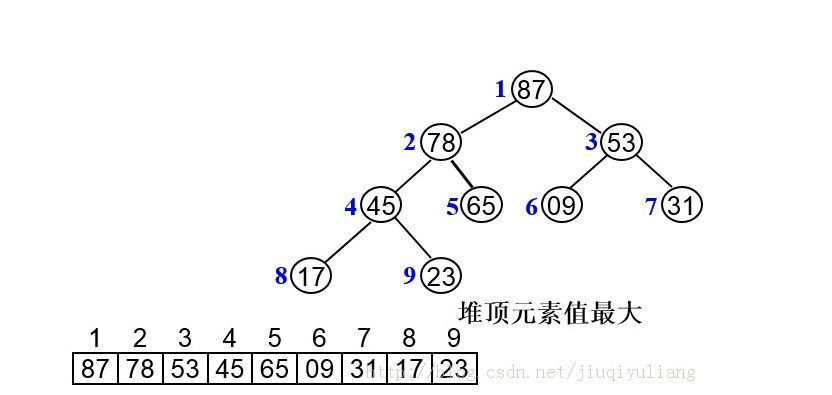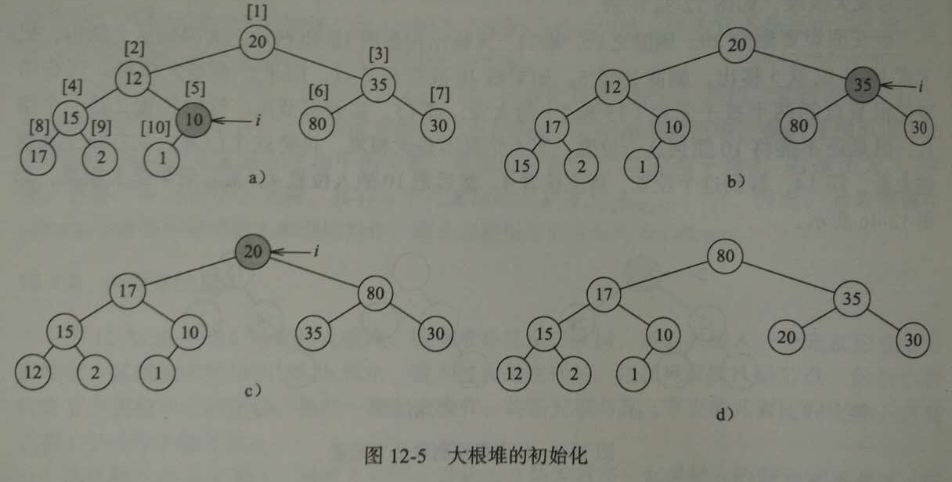一、优先级队列
优先级队列是0个或多个元素的集合,每一个元素都有一个优先权或值,对优先级队列执行的操作有:查找一个元素;插入一个元素;删除一个元素。在最小优先级队列中,查找和删除的元素都是优先级最小的元素;在最大优先级队列中,查找和删除的元素都是优先级最大的元素。优先级队列的元素可以有相同的优先级,对这样的元素,查找和删除可以按照任意顺序处理。优先级队列不同于一般的先进先出的队列的形式。以最大优先级队列为例,其C++的抽象类如下:
#pragma once
using namespace std;
//优先级队列的抽象基类
template<class T>
class maxPriorityQueue
{
public:
virtual ~maxPriorityQueue(){}
virtual bool empty() const = 0;//判断为空吗
virtual int size() const = 0;//返回队列的大小
virtual const T& top() = 0;//返回优先级最大的元素的引用
virtual void pop() = 0;//删除队列首元素
virtual void push(const T& theElement) = 0;//添加元素
};二、线性表描述
描述最大优先级队列最简单的方法是线性表。采用无序线性表描述时,插入操作很简单,但是查找和删除操作都要遍历整个线性表;采用有序线性表,查找和删除操作之间在表头或者表尾进行,但是插入操作就变得很麻烦。因此描述优先级队列最常用的是堆结构。
三、堆描述
二叉堆是一种特殊的二叉树,首先它必须是一个完全二叉树(或者近似完全二叉树),我们可以使用数组作为堆的物理存储结构;其次它满足以下性质:最大堆中双亲节点一定比左右孩纸节点要大,最小堆中双亲节点一定比左右孩子要小,并且每一个节点的左右孩纸又组成了一个最大堆(或最小堆)。
数组下标0不存放数据,从1开始。根据完全二叉树的性质,我们可以很方便的计算双亲结点和孩纸节点的下标之间的关系。
下图中演示了最大堆的插入操作,图a是一颗5元素的大根堆。当插入一个元素后,为了维持完全二叉树的性质,其树的结构必然为图b所示。整个插入过程是这样的,把新元素插入新节点,然后沿着从新节点到根节点的路径,执行一趟起泡操作,将新元素与其父节点的元素比较交换,直到后者大于等于前者为止。如果新插入的元素是1,那么最终结果如图b;如果插入5,那么因为5大于其父节点2,执行一次起泡,最终结果如图c;如果插入21,由于其大于父节点2,执行一次起泡,而21又比父节点20大,在执行一次起泡,最终结果如图d所示:
大根堆的删除操作,就是删除根节点的元素,删除之后堆结构要重新组织以维持大根堆的性质。为此,我们把最后一个节点的元素取出,然后删除该节点维持完全二叉树的结构,此时根节点为空,但我们不能把该元素直接放入根节点,我们应该从根节点开始向下逐级寻找位置。在上图12-3(d)中,删除21以后,把最后一个节点2删除,然后寻找元素2应该插入的位置,根节点肯定不行,根的左右孩纸中20比较大,我们将20提前到根节点,然后2放在右孩纸的位置,此时是合适的,最终结果如图12-3图a所示。在下图12-4中(a)模拟了这个过程。接着我们删除根节点20,删除后的树结构如下图b,我们删除最后一个节点10,然后寻找10应该插入的位置,也是从根节点开始找,我们把15提前到根节点,发现10不适合插入左孩纸的位置,继续向下寻找,把14提前,最后结果如图c所示。
在使用堆前,首先我们应该先建立一个堆,即堆的初始化。假设数组有n=10个元素,在数组a{1:10}中,元素的优先级为【20,12,35,15,10,80,30,17,2,1】。这个数组可以表示为下图12-5(a)的完全二叉树,接下来就要进行堆化。根据完全二叉树的性质,i=n/2是最后一个有孩纸的节点,我们从i开始往前遍历直到根节点1,对每一个节点都要堆化,以维持最大堆的性质。下图中,我们从节点5开始,符合最大堆的性质;接着看节点4,我们把17和15互换,如下图b;接着看3,以此类推。
整个操作的C++实现如下:
#pragma once
#include<iostream>
#include <sstream>
#include <algorithm>
#include"maxPriorityQueue.h"
using namespace std;
//堆是一个完全二叉树,使用数组存储在时间空间上有好处
template<class T>
class maxHeap :public maxPriorityQueue<T>
{
public:
//构造函数,复制构造函数和析构函数
maxHeap(int initialCapacity = 10)
{
if (initialCapacity < 1)
{ cerr << "The Capacity of Heap should be >0"; e







 本文介绍了数据结构中的优先级队列,通过线性表、堆和左高树三种方式详细阐述。堆,特别是二叉堆,作为实现优先级队列的常用方法,通过插入和删除操作的示例解释了其工作原理。左高树作为一种特殊二叉树,适用于解决优先级队列的合并操作。文章还提供了C++实现代码以加深理解。
本文介绍了数据结构中的优先级队列,通过线性表、堆和左高树三种方式详细阐述。堆,特别是二叉堆,作为实现优先级队列的常用方法,通过插入和删除操作的示例解释了其工作原理。左高树作为一种特殊二叉树,适用于解决优先级队列的合并操作。文章还提供了C++实现代码以加深理解。




 最低0.47元/天 解锁文章
最低0.47元/天 解锁文章

















 2074
2074

 被折叠的 条评论
为什么被折叠?
被折叠的 条评论
为什么被折叠?








